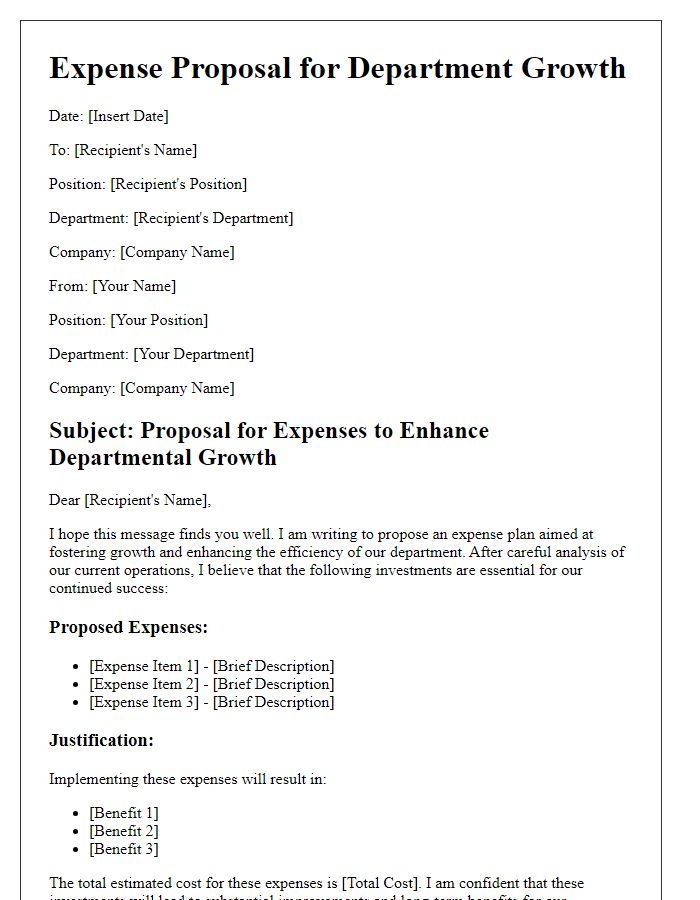Are you gearing up to propose your department's budget for the upcoming fiscal year? Crafting a compelling letter can make all the difference in securing the funds you need. In this article, we'll guide you through a tried-and-true template that highlights your department's priorities and aligns them with the overall goals of your organization. Ready to learn how to effectively present your case? Let's dive in!

Clear Objectives
Effective department budget proposals require clear objectives to ensure financial resources align with strategic goals. Setting specific targets enhances clarity, guiding funding allocations. For instance, aiming to reduce operational costs by 15% can direct attention towards efficiency measures. Additionally, establishing measurable outcomes, such as increasing project completion rates by 20% within the fiscal year, helps track progress and justify expenses. Clearly defined objectives facilitate communication among stakeholders, ensuring all departments understand priorities. Adopting a data-driven approach, using metrics from previous years, supports the rationale for requested budgets, enhancing overall credibility and effectiveness in budget negotiations.
Detailed Justification
The annual budget for the marketing department requires a detailed justification to ensure optimal allocation of resources for maximum impact. Proposed figures include a need for $250,000, covering digital advertising campaigns on platforms like Google Ads and Facebook, aimed at increasing brand visibility among targeted demographics. Additionally, a portion of $50,000 is earmarked for market research initiatives to gather actionable insights into consumer behavior trends, crucial for strategic planning. Furthermore, $30,000 is proposed for software tools management, including analytics programs such as HubSpot and SEMrush, enhancing campaign effectiveness through data-driven decision-making. An investment of $20,000 for professional development workshops will ensure the marketing team remains updated on the latest strategies and technologies. Collectively, these expenditures aim to elevate the department's performance by 15% in lead generation and customer engagement metrics over the upcoming fiscal year.
Itemized Budget Plan
An itemized budget plan provides a detailed financial overview essential for department budget proposals. It typically includes various categories such as personnel expenses (salaries and benefits for staff members), operational costs (utilities, office supplies), and project-specific allocations (funding for upcoming initiatives). Each item should specify the estimated cost, frequency of expenditures (monthly, annually), and justification for necessity based on departmental goals and objectives. For example, a training seminar for staff development may be allotted $5,000, while technology upgrades could be proposed at $10,000 for software licensing. Accurate estimates and clear justifications enhance the credibility of the proposal, facilitating review and approval processes by budget committees or financial decision-makers. This level of detail allows for strategic planning, ensuring all financial needs align with the department's mission within the larger organizational framework.
Executive Summary
The department budget proposal outlines financial requirements for the fiscal year 2024-2025, aiming to support initiatives enhancing operational efficiency and project development. Key allocations include $500,000 for technology upgrades, focused on integrating AI-driven tools to streamline workflows across teams such as marketing and finance. Additionally, a proposed $300,000 for staff training programs aims to elevate skills in data analytics, essential for informed decision-making. The proposal anticipates an expected 15% increase in overall productivity, directly correlated with these investments, while also addressing urgent facility improvements estimated at $200,000 for updating equipment at the headquarters in downtown Chicago. Each segment of the budget aligns with strategic goals outlined in the annual departmental strategy report, emphasizing accountability and transparency in fiscal management.
Timeline and Milestones
Budget proposals for departmental projects require careful planning, ensuring all necessary milestones are accounted for to track progress. A typical timeline spans several phases, including preliminary assessment (usually lasting 2-3 weeks), budget drafting (3-4 weeks), stakeholder reviews (2 weeks), and final adjustments based on feedback (2 weeks). Submission deadlines for the budget proposals are commonly set for late November to ensure alignment with the overall organizational fiscal planning cycle. Implementation begins upon approval, involving key milestones such as resource allocation, staff training, and project kickoff, often scheduled for the first quarter of the following year. Regular progress checks are established bi-weekly during the implementation phase to ensure adherence to the timelines established in the initial proposal.
















Comments